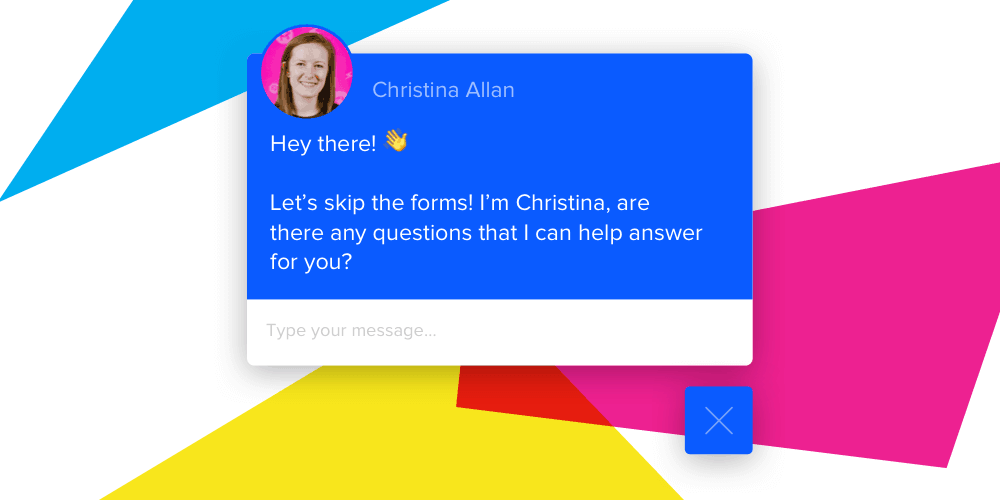
Editor’s Note: The following is a guest post from Drift Partner New Breed. Interested in contributing content to the Drift blog? Email Molly Sloan at msloan@drift.com.
Someone starts doing research on a challenge they have. They Google a phrase, find your website and read your blog post. They liked what they read and found it valuable, so they decide to click the CTA at the bottom of the page for a content offer. They’re then taken to a landing page where they have to fill out a form. When they submit that form, they’re redirected once again to a thank you page where they might be able to download the content offer, but they might also have to check their email for it.
That process provides the lead with a valuable content offer and you with information that can be used for further follow-ups, so everyone wins, right?
That lead generation process, which is prevalent in the B2B industry, contains a lot of steps and a lot of friction, but conversational marketing can achieve the same goal in a better way.
All the Leads, None of the Inconvenience
Chatbots allow you to generate leads without disrupting the site visitor’s experience.
Bots can be leveraged to surpass the disconnected steps involved in traditional lead generation and capture the same information while serving the requested content offer on the spot without forcing the site visitor to leave the blog post they’re on.
Tools like Drift allow you to greet qualified prospects where they’re at, provide a call-to-action and convert them — all in a small box in the corner of your browser.
The contextual relevance and personalization of the one-on-one conversation a bot can provide will compensate for any perceived intrusion created when the bot’s initial greeting pops up.
If your bot recognizes a qualified visitor reading a blog post, it can reach out and say something like “hey [company], welcome to our site. I see you’re checking out this post on conversational marketing. I think you might be interested in these other pieces of content as well.”
That next level customer service can leave a lasting impression for site visitors.
Real-time Customer Engagement
You can’t replicate the in-the-moment communications through other types of marketing communications, like email nurture campaigns. Even if you’re sending personalized, contextually relevant emails, those follow-up emails are still disconnected from the site visitor’s browsing experience.
If someone’s on your website browsing now, but you don’t follow-up for three business days when they’re also combing through tons of other emails in their inbox, they’re a lot less likely to convert than if you were to reach out to them when they were on your site engaging with just your company and your content.
If you’re using chat and a visitor wants to book a demo, they can do it immediately when they’re on the website instead of having to wait for an email response a week later.
Sales Chat Best Practices
When you initiate any conversation, keep the end goal in mind: providing value for the site visitor. Instead of pushing a meeting or a demo, structure your conversation around what the visitor is looking for.
- Be quick to reply. For you to provide real-time engagement, you have to respond in real-time. Make sure you always have someone monitoring your sales chat. If no one from your sales team is available, this could also be a marketer or customer service rep.
- Have a good icebreaker. You’re chatting with someone who chose to come to your site, not conducting cold outreach, so don’t start the conversation like “Hi, this is Jane. I’m a BDR at New Breed.” Instead, start with “Hey” or “How are you?” as if you were texting an acquaintance.
- Be a good listener. While you’re not technically “listening,” pay attention to what the visitor is writing. Use the information they’re providing you with to help them diagnose their challenge. While doing this, restate what they’re telling you back to ensure you’re on the same page.
- Know when it’s appropriate to take the conversation off chat. If you don’t know your angle for the sale, it’s too early to jump on a sales call. If you try and book a meeting too soon, you can spook the visitor, and if you wait too long, you can miss your opportunity. Use the information they’re telling you in combination with the data your chat tool knows about them to determine when the time it right to move off chat.
- Conduct follow-up outreach to reinforce you’re a real person. If a site visitor converted during your conversation, connect with them on LinkedIn or Twitter to follow-up. This continues the top notch customer service that meets the lead where they’re at and proves they were chatting with a human, not just a super smart bot.
The Takeaway
Forms are outdated. People want conversations more than they want to fill out forms.
Being able to use conversational marketing tools for automated conversations and sales chat allows you to be more timely in your marketing and sales communications, and in turn, boosts conversions.
The customer service and conversationality of your sales chat conversations should continue into future interactions as well, as you continue to provide a superb sales experience.
Amanda Nielsen is a partner marketing strategist at New Breed, a full-funnel marketing and sales agency. She drives growth for New Breed by leveraging content creation, lifecycle marketing, and multi-channel inbound marketing strategies to engage and delight prospects into customers and ultimately, brand evangelists.






